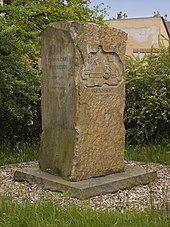Johann Carl Free Life
Johann Carl Freiesleben (born June 14, 1774 in Freiberg , † March 20, 1846 in Niederauerbach ) was a Saxon mining captain .
Live and act
He came from a miners family from Freiberg and drove his first shifts as a high school student . After graduating from high school, he attended the Bergakademie Freiberg from 1790 to 1792 , where Abraham Gottlob Werner promoted free life. At the Bergakademie he met Alexander von Humboldt , Christian Leopold von Buch and Ernst Friedrich von Schlotheim , with whom he went on several educational trips. Free life remained friends with von Humboldt throughout life.
Free life studied law at the University of Leipzig from 1792 to 1795 . From there he undertook explorations in the Harz Mountains . After completing his studies, he went on a trip to Savoy and Switzerland with Humboldt . After his return he got a job in 1796 as Mining Authority Assessor in Marienberg and 1799 as Mining Master of the Mining Authority Johanngeorgenstadt .
In 1800, Freieleben was appointed to work as a mountain commissioner , chief mountain bailiff in Thuringia and director of the Mansfeld mines in Eisleben . Here he presented several publications on improving copper slate mining .
When Eisleben was assigned to the Kingdom of Westphalia in 1808 , he returned to Freiberg and became an assessor of the local Oberberg- und Hüttenamt and later promoted to the Bergrat. After the death of the chief miner Sigismund August Wolfgang von Herder , he took over the management of the Saxon Mining Authority from 1838 to 1842 .
The University of Marburg awarded him a doctorate in 1817 and the Academy of Sciences in Berlin appointed him a corresponding member in 1828. In 1818, Freieleben donated 212 pieces from its geognostic mineral collection from the Freiberg area to the Prussian mountain school in Eisleben .
Free life died on a business trip in the brass works in Niederauerbach in Vogtland, which he ran . He was buried in the Donatsfriedhof in Freiberg.
The mineral Freielebenit and the fossil fish Palaeoniscum freilebeni , a ray- finned fish from the Permian period, were later named after the researcher. He himself discovered the mineral Covellin, which he called blue copper glass , near Sangerhausen in 1815 .
Fonts (selection)
Free life left numerous publications. He is said to be the founder of the stratigraphic part of geognosy for northern Germany.
- Mineralogical remarks on the Shimmering Fossil from the Baste near Harzburg: particularly with regard to its geognostic occurrence , Leipzig 1794
-
Remarks about the resin
- Vol. 1: Miners' remarks on the strangest part of the Harz Mountains , 1795 ( digitized version )
- Vol. 2: Mineralogical remarks on the occasion of a trip through the strangest part of the Harz Mountains, 1795 ( digitized version )
- Geognostic contributions , 6 volumes, Freiberg 1807/15
- Systematic overview of the literature on mineralogy, mining and metallurgy from 1800 to 1820 , 1822 ( digitized )
- Magazine for the oryctography of Saxony - A contribution to the mineralogical knowledge of this country and the history of its minerals , Freiberg 1828
- On the occurrence of salty fossils and the salt and mineral springs in Saxony , Freiberg 1839
- The Saxon ore veins arranged in local order according to their formations
- On the occurrence of the combustible fossils in Saxony , Freiberg 1845 ( digitized version )
- On the occurrence of gold and mercury ores in Saxony , Freiberg 1846
-
From the occurrence of silver ores in Saxony
- Vol. 1: On the occurrence of solid silver, horn ore , silver black and glass ore , Freiberg 1847
- Vol. 2: On the occurrence of brittle glass ore, white gold tiger ore , red gold tiger ore and some other silver ores , Freiberg 1847
- From the occurrence of copper ores in Saxony , Freiberg 1848
- Contributions to the history, statistics and literature of the Saxon ore mining, with special consideration of the duct formations , Freiberg 1848 (from the estate edited by Hermann Müller ) ( digitized version )
literature
- Wilhelm von Gümbel: Free life, Johann Karl . In: Allgemeine Deutsche Biographie (ADB). Volume 7, Duncker & Humblot, Leipzig 1877, p. 339 f.
- Hanns Freydank: Free life, Johann Karl. In: New German Biography (NDB). Volume 5, Duncker & Humblot, Berlin 1961, ISBN 3-428-00186-9 , p. 395 f. ( Digitized version ).
Web links
- Literature by and about Johann Carl Freiesleben in the catalog of the German National Library
- Literature by and about Johann Carl Free Life in the Saxon Bibliography
Individual evidence
- ^ Andreas W. Daum: Alexander von Humboldt . CH Beck, Munich 2019, p. 27-28, 34, 61 .
| personal data | |
|---|---|
| SURNAME | Free life, Johann Carl |
| BRIEF DESCRIPTION | Saxon miner captain |
| DATE OF BIRTH | June 14, 1774 |
| PLACE OF BIRTH | Freiberg |
| DATE OF DEATH | March 20, 1846 |
| Place of death | Niederauerbach |



